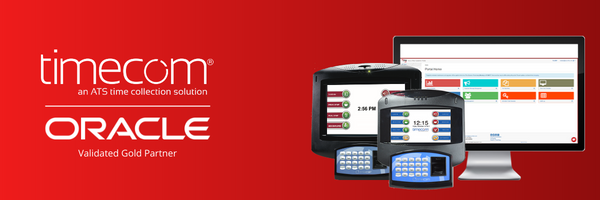Healthcare environments demand top-tier workforce management tools like Oracle time and labor for Healthcaret. However, the true optimization of such a solution lies in seamless integration with a robust time and attendance system.
Effective Time Tracking Delivers Payroll Accuracy
With so many people living paycheck to paycheck, inaccurate paychecks do more than inconvenience your staff. Especially with the challenging task of working in healthcare, it’s vital to have your Oracle system pay them accurately.

Integrating your Oracle Time and Labor software with an advanced employee time clock system, such as ATS’s Timecom solution, empowers you to seamlessly handle the significant task of properly compensating a large, complex workforce.
The best time tracking solution for healthcare settings has an employee time clock which is important for accurate payroll and happy employees.
Here are some key questions you should consider when selecting the terminal for collecting critical payroll data.
1. What is the employee's experience like while using the time clock?
The time clock interface should be intuitive and provide simple directions. Employees coming in to and leaving a hectic healthcare environment want a smooth and fast time clock experience.
If employees struggle with the time clock, managers and payroll teams must manually track their time. This creates an additional workload for the payroll department and raises the likelihood of errors in paychecks.
2. Will the time clock operate if it gets disconnected?
Every hospital has its contingency power sources and plans if the facility loses power. Reliable time clocks also have secondary power sources. Equally important, they continue to track employee time even if they’re not connected to the network.
ATS time clocks have the space and memory to store employee punches locally. After the network communication is restored, the employee punches are sent to Oracle Time and Labor for Healthcare.
3. How does the time clock improve payroll operations beyond replacing manual timesheets?
The time clock should come with advanced functionality. For example, most ATS time clocks:
- Come with a big, high-def screen that improves user experience, allowing workers to use and see the functions that are hard on smaller screens. For example, workers can look up their schedules at the time clock due to the two-way integration with Oracle. They can attest on screen that they didn't witness any workplace accidents or that they came back from lunch early on their own.
- Can prevent an hourly healthcare employee from clocking in too early or coming back from a break too soon, helping contain labor costs.
- Can limit which employees can use specific time clocks based on location. This feature is useful in big workplaces, such as a hospital, to guide employees to their work area.
- Deliver data in near real-time so payroll and all other departments always work with current information.
An advanced time clock does much more than collect dates and times. Find out what functionality a specific time clock has that can help payroll meet its operational and legal obligations.
4. Why isn’t a mobile or online time clock an option For Healthcare Environments?
Online or mobile time clocks have many drawbacks, especially in healthcare workplaces where most employees don't use personal computers. That makes software-based time clocks impractical.
When employees use a dedicated device to clock in, it makes them work more efficiently in two ways:
- Employees can clock in and out quickly, without waiting for a computer to come available.
- Computers remain available for urgent work-related tasks.
Understand What Your Company Needs from the Right Time Clock
You’ll find a wide range of price points on time clocks. Keep in mind a cheap time clock comes with hidden costs.
Nor will they fully meet healthcare organizations' needs to maximize the potential of the Oracle Healthcare system. Specify the necessary data from the time and attendance system for precise and fully automated payroll. Ask vendors about additional employee time clock functions that can enhance your use of Oracle.
Armed with this information, you can make an informed decision about what time clock meets your organization’s needs.
Contact us today to learn about our certified and integrated solutions.





